The record surge in greenhouse gas concentrations in the atmosphere is committing the planet to rising temperatures for many years to come, the UN weather agency said on Thursday.
—
Atmospheric concentrations of all three major planet-warming greenhouse gases reached new highs in 2023, committing the planet to rising temperatures for many years to come, according to new report published ahead of the year’s most important UN climate summit.
When the World Meteorological Organization (WMO) released its first assessment 20 years ago, carbon dioxide (CO2) concentrations stood at 377.1 parts per million (ppm). They have grown by 11.4% since, hitting a new record of 420.0 ppm last year.

Carbon dioxide, a by-product of burning fossil fuels, biomass, land-use changes, and industrial processes such as cement production, is the principal anthropogenic greenhouse gas in the atmosphere, responsible for about three-quarters of planet-warming emissions. Global CO2 emissions from fossil fuels have increased by more than 60% since 1990, with atmospheric concentrations now 51% higher than they were before the onset of the Industrial Revolution.
Because of its extremely long durability in the atmosphere, the world is now “committed to rising temperatures for many, many years to come,” WMO’s Deputy Secretary-General Ko Barret said during a press conference on Thursday.


Concentrations of methane (CH4) in 2023 were 1,934 parts per billion (ppb). Methane – a gas mainly associated with fossil fuel use, agriculture and waste – is the second major greenhouse gas after CO2, responsible for 25% of global warming. It is 84 times more potent in trapping heat in the atmosphere than CO2 over a two-decade period and it possesses a 100-year global warming potential 28-34 times that of CO2. Global methane emissions have been on the rise and atmospheric concentrations of the potent gas are now more than 165% higher than pre-industrial levels in 1750.
Meanwhile, concentrations of nitrous oxide (N2O) climbed to 336.9 ppb. Nitrous oxide is the third-most significant human-caused greenhouse gas. It is mainly associated with the use of nitrogen fertilizer and manure from the expansion and intensification of agriculture. Atmospheric concentrations of this gas are now 25% higher than the pre-industrial level of 270 ppb.
‘Another Year, Another Record’
Aside from the relentless burning of fossil fuels, emissions from wildfires likely contributed to the jump in emissions, which grew from 417.9 parts in 2022, according to the report. A study published in August in Earth System Science Data (ESSD) concluded that the total amount of carbon emissions generated from all fire events combined last year was 16% above average, totalling 8.6 billion tonnes of CO2.
Canada was responsible for about 23% of these emissions. The country endured its most devastating fire season on record last year, with nearly 6,600 blazes burning across 45 million acres – 5% of the entire forest area of Canada and roughly seven times the annual average – and affecting 230,000 people.

But a possible reduction in carbon sinks may have also contributed last year’s total emissions, WMO said. Preliminary findings by an international team of researchers earlier this month showed that land absorbed almost no carbon in 2023, the hottest year on record.
More on the topic: What Are Carbon Sinks?
“Another year, another record,” said WMO Secretary-General Celeste Saulo. “Every part per million and fraction of a degree temperature” matters and has a “real impact” on people’s lives and the planet, she said, from rising temperatures to sea level rise, glacier and ice retreat, and ocean acidification.
Fossil Fuel Era
The burning of coal, natural gas, and oil for electricity and heat is the single-largest source of global greenhouse gas (GHG) emissions, the primary drivers of global warming by trapping heat in the atmosphere and raising Earth’s surface temperature. Global fossil fuel consumption has more than doubled in the last 50 years, as countries around the world aim to improve their standards of living and economic output. In 2023, all three of the most potent GHGs – carbon dioxide (CO2), methane, and nitrous oxide – reached record highs.
The International Energy Agency (IEA) has urged countries to halt new gas and oil field projects, arguing that this is the only way to keep the 1.5C-compatible net-zero emissions scenario alive.
Last week, the UN said the world is on track to warm up to 3.1C over the course of this century, warning that cuts of 42% by 2030 and 57% by 2035 are needed to get on track for 1.5C of warming.
How can I contribute to a more sustainable planet?
- 🗳️ Vote for Climate Action: Exercise your democratic rights by supporting candidates and policies that prioritize climate change mitigation and environmental protection. Stay informed with Earth.Org’s election coverage.
- 👣 Reduce Your Carbon Footprint: Make conscious choices to reduce your carbon footprint. Opt for renewable energy sources, conserve energy at home, use public transportation or carpool, and embrace sustainable practices like recycling and composting.
- 💰 Support Environmental Organizations: Join forces with organizations like Earth.Org and its NGO partners, dedicated to educating the public on environmental issues and solutions, supporting conservation efforts, holding those responsible accountable, and advocating for effective environmental solutions. Your support can amplify their efforts and drive positive change.
- 🌱 Embrace Sustainable Habits: Make sustainable choices in your everyday life. Reduce single-use plastics, choose eco-friendly products, prioritize a plant-based diet and reduce meat consumption, and opt for sustainable fashion and transportation. Small changes can have a big impact.
- 💬 Be Vocal, Engage and Educate Others: Spread awareness about the climate crisis and the importance of environmental stewardship. Engage in conversations, share information, and inspire others to take action. Together, we can create a global movement for a sustainable future.
- 🪧 Stand with Climate Activists: Show your support for activists on the frontlines of climate action. Attend peaceful protests, rallies, and marches, or join online campaigns to raise awareness and demand policy changes. By amplifying their voices, you contribute to building a stronger movement for climate justice and a sustainable future.
For more actionable steps, visit our ‘What Can I do?‘ page.
This story is funded by readers like you
Our non-profit newsroom provides climate coverage free of charge and advertising. Your one-off or monthly donations play a crucial role in supporting our operations, expanding our reach, and maintaining our editorial independence.
About EO | Mission Statement | Impact & Reach | Write for us














